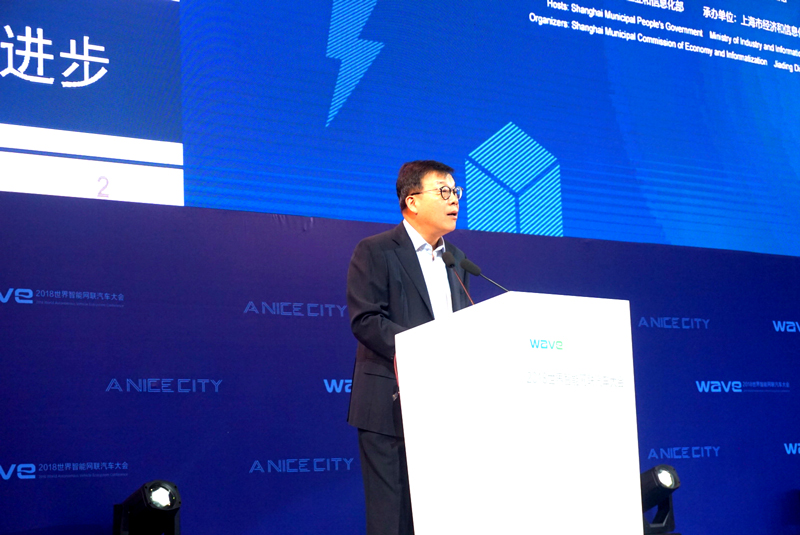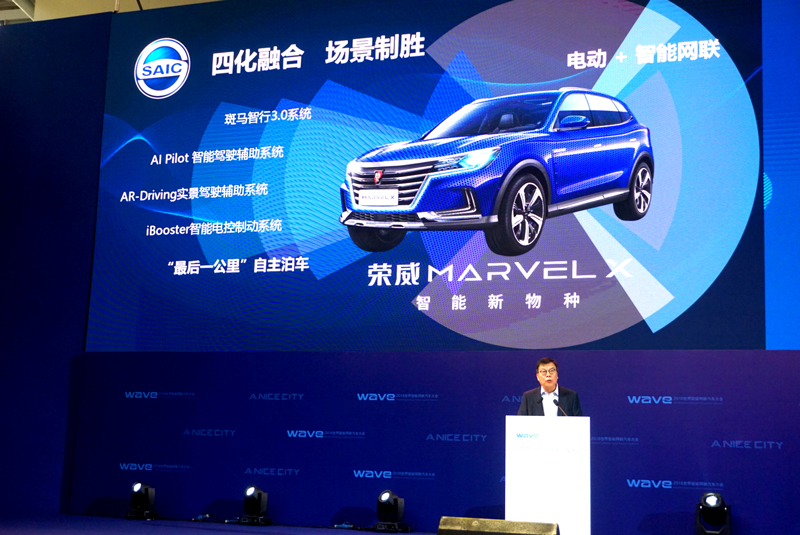Chen Zhixin: Intelligent connected vehicles are more than being smart

At the opening ceremony of the 2018 World Intelligent Connected Vehicles Conference held on Sept 18, 2018, Chen Zhixin, president of SAIC Motor Corporation Limited (SAIC Motor for short) shared, on behalf of the domestic auto manufacturers, SAIC Motor’s ideas and practices in developing the intelligent connected vehicles (ICVs).
Chen said: “The reason why SAIC Motor decides to make ICVs is not just to make vehicles more intelligent, but to strengthen, from a broader perspective, the whole auto industrial chain, including the manufacturing process and mobility services, by leveraging the big data, artificial intelligence and internet technologies. We aim to provide overall services for customers covering the full life circle of vehicles from manufacturing to use, by integrating the front-end and back-end services, traditional and modern crossover technologies, as well as products and services, to better meet the needs of customers for personalized and intelligent vehicles and mobility services that guarantee a sound experience. In this way, we hope to promote the transformation and upgrading of the auto industry via intelligent connectivity technologies and build a future-oriented new business ecosystem.”
Innovation resources integration
In recent years, SAIC Motor has been accelerating its application of intelligent connectivity technologies by integrating advanced global innovation resources and leveraging its own advantages in the auto industrial chain and innovation field.

It has been vigorously driving the development of the machine vision based intelligent engine control unit (i-ECU), the core element of ICVs, and has completed the world’s largest OTA (over-the-air) upgrade of its Banma 3.0 smart system, an in-vehicle infotainment system based on human-computer interaction, which is now equipped in all its existing internet-based cars. It has also been accelerating the R&D of an intelligent braking system and steering system of the chassis for both its self-owned brands and joint ventures, and has been working on building the first generation of production platform for high-precision maps of ICVs.
In developing Vehicle-to-everything (V2X) communications, SAIC Motor has cooperated with China mobiles and Huawei via the 5G Automotive Association platform to engage in and promote the formulation of in-vehicle wireless communications solutions and standards. It has so far completed developing and testing 18 V2X functions, and has established models for intelligent driving testing and vehicle testing that are in compliance with normal driving conditions and standards.
In terms of road tests, SAIC Motor’s self-driving vehicles have finished a total testing distance of more than 75,000 kilometers. On March 1, 2018, the company obtained the first license in China to conduct open road tests of ICVs, and conducted a real car test on a 5.6 km stretch of open road at the Shanghai International Automobiles City in Jiading district, with the total testing distance exceeding 5,500 km.
SAIC Roewe Marvel X
Thanks to the company’s innovative application of intelligent connectivity technologies and its long-accumulated advantages in developing new-energy-vehicles (NEVs), SAIC Motor launched its internet-connected electric SUV Marvel X this year, the rear-wheel-drive and all-wheel-drive versions of which were first available on pre-sale at an auto show in Chengdu, Sichuan province in late August. The Marvel X Pro with a self-parking function will be launched at the end of the year.
The car is equipped with several industry-leading technologies, such as the latest Banma 3.0 smart system, the AI Pilot intelligent drive auxiliary system, the AR-Driving augmented reality driving auxiliary system and the iBooster intelligent electrically controlled brake system. It will be the world’s first mass-produced vehicle with the function of self-parking.
The launch of SAIC Marvel X is of ground-breaking significance, as it not only represents an important step of the company’s exploration in commercializing intelligent-drive technologies to solve customers’ parking problems and reduce their driving burden, but also contributes significantly to the development of ICV worldwide.
Integrated development
Chen said: “Innovation is a constant process in the same way that species are always evolving. Technologies may change in the development of ICVs, but our original intention will never change, which is, to better meet customers’ varying needs for vehicles and create a better car-using experience for them.” Faced with the needs of the new-generation customers for personalized and intelligent vehicles and mobility services that guarantee a sound experience, SAIC Motor will strive to provide overall services for customers covering the full life circle of vehicles from manufacturing to use, by integrating the front-end and back-end services, traditional and modern crossover technologies, as well as products and services, so as to build a future-oriented new business ecosystem.
By integrating the front-end and back-end services, the company will endeavor to meet customers’ personalized needs with Customer to Business (C2B) mass customization. With the development of internet and artificial intelligence technologies, the direct connection between customers and manufacturers is made possible, which facilitates the integration of the front end (R&D and manufacturing) and the back end (user services). SAIC Motor created the C2B mass customization business model to enable customers to engage in the whole process of auto making, including the design, development, test, parts selection, pricing and improvement of a vehicle. Users may “customize” an ideal car on an intelligent platform according to their own needs and raise suggestions for improvement. Their feedback will also be immediately sent to the R&D and manufacturing end via big data, to serve as first-hand information for future vehicle improvement. SAIC Motor has already piloted C2B mass customization in two of its car models, and will apply it in more car models in the following years. By using digital and intelligent technologies, the company aims to promote the revolution of the auto manufacturing industry and the supply chain system, to realize client-oriented development and boost the manufacturing industry.
By integrating traditional and modern crossover technologies, the company intends to drive the upgrading of its products via intelligent connectivity. As vehicles turn smarter under the support of intelligent connectivity, traditional and modern crossover technologies are tending to blend with each other. On the one hand, vehicles are infused with “new features”. With the rapid development of 4G and the up-coming 5G technologies, mobiles internet-based function has become an important new feature of vehicles, and cyber security has become a new part of automobiles safety. In addition, the operating system and the chips have been playing an increasingly significant role in a vehicle, and the software and data algorithm have been exerting a larger influence in the intelligence level of a car. In the future, “soft power” will be the core standard in evalsuating a car’s performance, as well as the major determining factor that affects the using experience. On the other hand, traditional technologies have been undergoing “new development”. For example, the electric drive system, intelligent braking system and steer-by-wire system have come out with the development of the electrification and intelligent technologies. The chassis system has seen great improvement in its complexity, precision and electrification degrees. The overall high-tech content in a vehicle has significantly increased.
By integrating products and services, the company intends to improve its intelligent mobility services for customers. SAIC Motor has planned the integration of products and services ever since it began to design the ICVs, with the goal of providing one-stop services for customers and enabling them to enjoy maximum convenience and efficiency when using the car. The company established an artificial intelligence lab this year to facilitate the provision of intelligent mobility services. Starting from providing car rental, finance & insurance, and maintenance services, it expects to introduce more external resources to help build a new business ecosystem that is client-oriented and offers overall solutions for people’s mobility.
Intelligent connectivity is an important trend in the development of the auto industry, and ICVs shall have a bright future in China. SAIC Motor will stick to promoting its innovation strategy to support its new targets: Electrification, Intelligent Connectivity, Sharing and Globalization, and accelerate its transformation into a comprehensive mobility service and product supplier, so as to help create a better car-using experience for customers.

